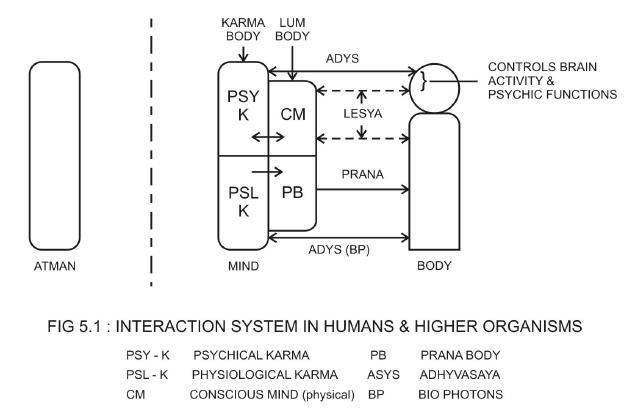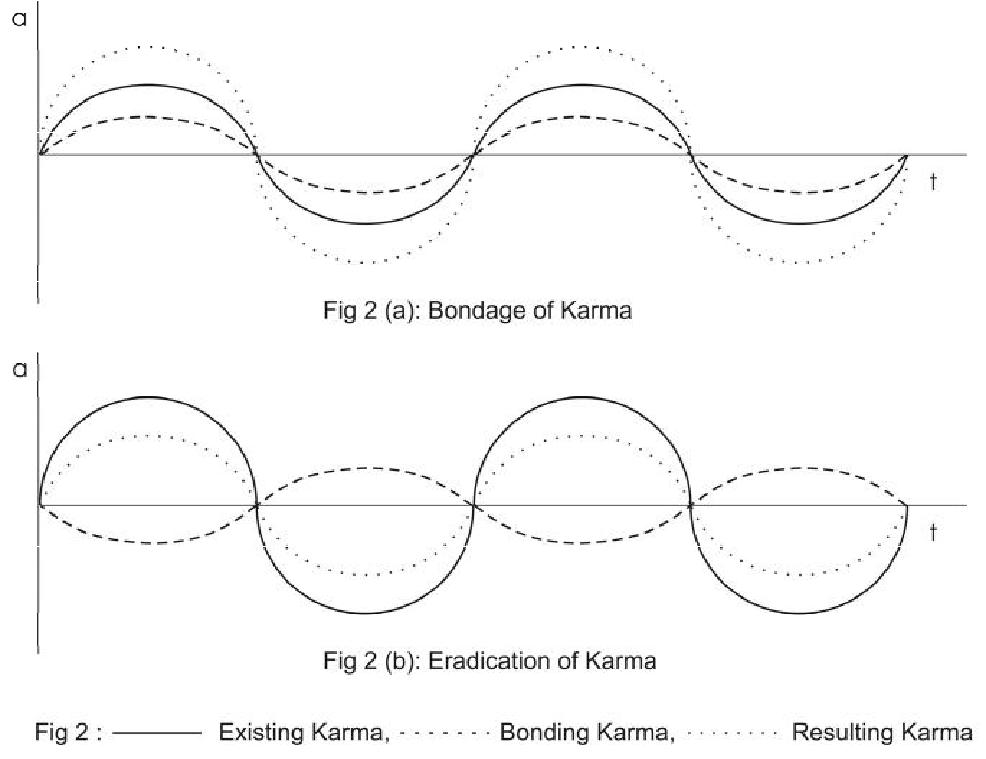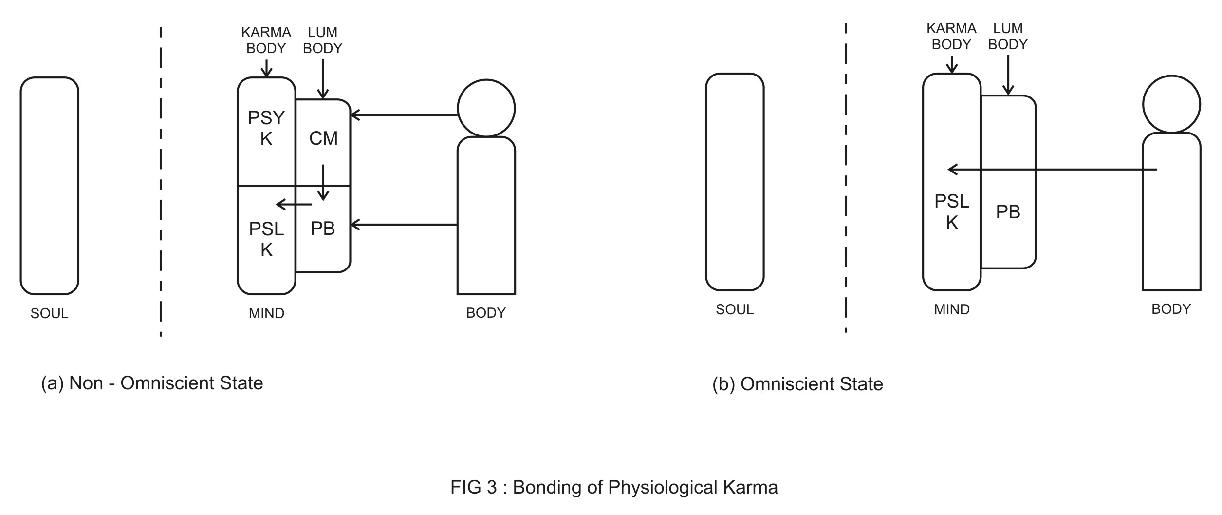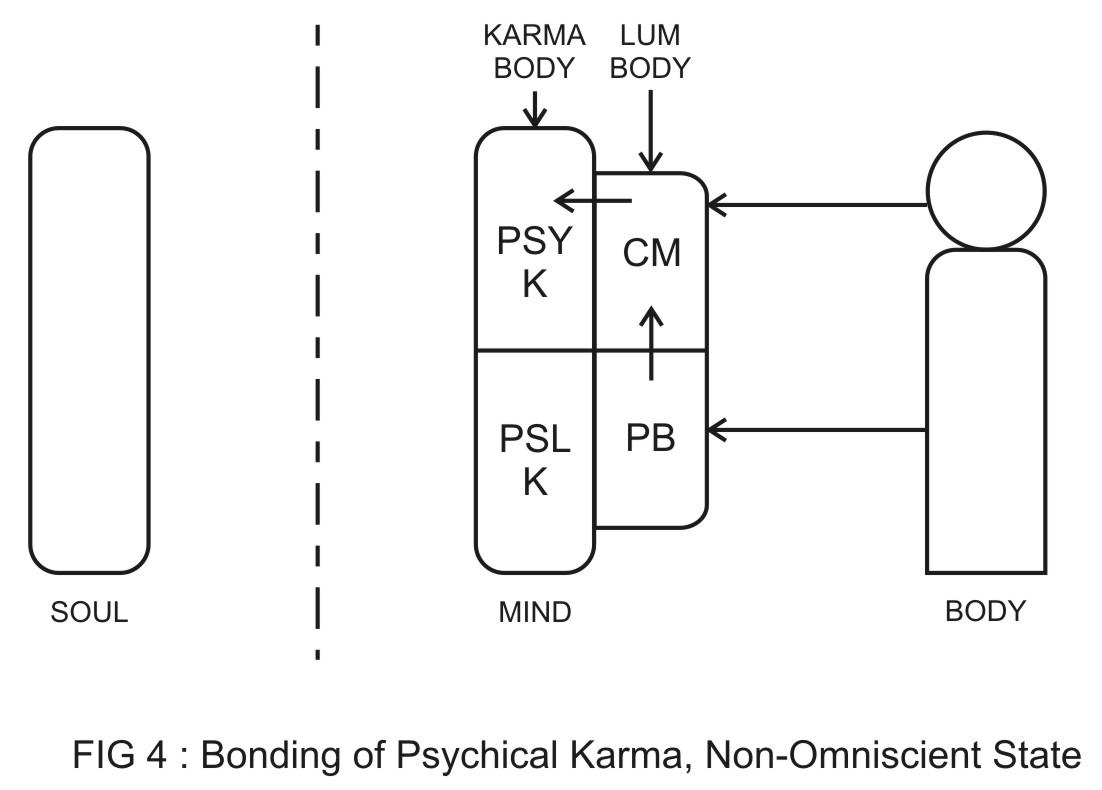National Seminar on Jain Mathematics: Historical and Theoretical Aspects. Ladnun, 2009
1. IntroductionDoctrine of Karma is the central principle in Jain philosophy and many other Indian philosophies. Soul bonds Karma of various kinds for the activities of body, mind and speech. It is only the Jain philosophy that also describes the mechanism of bondage. According to this philosophy the soul has two subtle bodies, the karma body and the fiery body. The karma body bonds karma when the soul acts in some way. An impure soul experiences vibrations due to changes in its state and induces similar vibrations in the karma body. The vibrating karma body attracts karma vargana from cosmos and bonds karma. This description relates the activities of the soul and karma body but does not give any idea of the connection between the material body and karma body which is necessary to understand the mechanism of bondage from scientific point of view. We attempt below to explore a possible scientific explanation of karma bondage.
2. The subtle Bodies
There are eight main types of karma which are grouped in two divisions, psychical (Ghatin) karma and biological (Aghatin) karma. Ghatin karma include intelligence obscuring, intuition obscuring, deluding and energy obscuring karma and aghatin karma include morphological karma, feeling producing karma, age determiningkarma and inheritance determining karma. The fiery body, which is said to be an electric body, is supposed to consist of two parts the conscious mind and the prana body. Fig. 1 shows interaction between the various bodies of a human being [1]. The prana body is the creation of physiological karma; it lasts as long as these karmas are in existence. The conscious mind (dravya manah) comes in existence in the five-sense organisms when the veil of psychological karma has thinned down. The conscious mind is linked to the brain and the nervous system and through it to the endocrine gland system. The prana body is connected to every cell of the body; the cell cannot function without prana.
Prana body supplies prana energy to cells through a system of nadies and meridians.
Chakras located on nadies act as energy distribution centers, each chakra supplies energy to a specific part of the body. There are ten pranas (dravya) in Jain philosophy defined by the functions performed by them; all of them originate from the prana body.
The soul extending the whole body is supposed to consist of innumerable parts (pradesa), each part carries total and identical karma. This means that the soul pradesa and the cell have a kind of one-to-one relationship making the interaction between karma and cell a local phenomenon. The karmas are expected to interact with DNA, and modify it suitably to affect transformation in the body for realizing the effect of rising karma.
The karma body, prana body and conscious mind or made of karma vargana, tejas vargana and mano vargana respectively which are mass less subtle energy fieldslike plasma. The karma field may be coherent so that it can code and decode and store a large amount of information for long durations and communicate this information through emissions to DNA which are frequency sensitive. There is scientific evidence that such a coherent field exists in the bodies of all living organisms that emits bio photons which are supposed to control and regulate the chemical activity in cells.
3. Bonding of Karma
The bonding of karma is expected to take place on the principle on which a radio works. In radio transmission the electrical signals of sound are magnified by an oscillator and transmitted to space after modulation. In a radio receiver the tuner receives signals of a particular frequency, which are then demodulated, amplified and sent to the speaker.
In the case of an organism it is expected that the signals are generated in the material body, amplified in the fiery body and modulated / demodulated in the karma body. The fiery body has two parts, the prana body and the conscious mind and so there are two possible paths of bonding of karma.
The relationship of soul with the karma body is governed by the principle of parallelism. The soul is directly related to karma body and no other body. The relationship of other bodies like the gross body, fiery body and the conscious mind with the soul is through the karma body. This relationship must be understood clearly in order to understand the functioning of the body system.
Any activity of the body, speech and mind excites the karma body, either making a particular karma to rise or bonding a new karma. The soul experiences the change and assumes a new state corresponding to the changed state of karma body. Any activity of body through some sense organ or combination of senses is registered by the karma body either through the conscious mind or without involvement of conscious mind. The activities of body, mind and speech produce a signal that activates the karma body and the soul recognizes the change in the karma body. It is obvious that the soul does not know the activity that does not change the karma body. Interaction of the soul with an external object must accompany with some kind of activity of mind, body or speech. This implies that the soul knows the object when a change in the karma body takes place; in the absence of change in karma body the soul is unaware of the external object. For example a liberated soul is free of karma body and, therefore, does not interact with the external world.
Any activity of body, mind and speech changes the state of the soul. Conversely, a change in the state of the soul would cause some activity of mind, body or speech. For instance, a change of heart signifying a change in the state of the soul would result in a change of state of the mind. All such interactions take place through the karma body which keeps record of all changes. The karma body is thus an interface between the soul and other bodies and between the soul and the external world through these bodies. On elimination of karma the soul looses connection with all bodies.
The above description gives the impression that the soul is a slave of karma. This is not the case. The soul can experience a change by himself due to his will power without the force of karma. Such a change in the state of the soul is known as parinamik bhava or self-change. When this happens the karmas adjust automatically to maintainthe equilibrium by the principle of parallelism. The soul is definitely more powerful than karma.
3.1 The Prana Body Path
The activities of body, mind and speech causes flow of bio electricity in the body. These electrical changes induce flow of current in the prana body. The prana body acting as an oscillator amplifies the signals, and these induce vibrations in the karma body, which acts as a tuner/ modulator / demodulator. Karma varganas of the same frequency are attracted from the cosmos by the principle of resonance and are superimposed on the existing karma. The karma varganas and the karma may behave as particles (mass less) or waves depending on the action they are called upon to perform, exhibiting a dual nature. When karmas attract karma varganas both behave as waves. The karmas in the bonded state, particularly in the passive period, may remain in particle form. In the fruition state the karma behaving as wave interacts with other bodies. Similarly the fiery body, the conscious mind and prana body must also have dual nature. The mutual interaction of these bodies and their interaction with DNA, takes place as waves. The bonding of karma thus is a process of superposition of two waves, one that of the existing karma and the other of incoming karma vargana, both of same frequency as shown in fig 2 (a). The two waves if in the same phase shall result in a coherent field. The elimination of Karma means super position of two waves of same frequency but having 1800 phase difference so that they nullify each other as shown in fig 2 (b). The karma is distinguished by the frequency that is each type of karma has a specific frequency; the numerical strength of karma must be proportional to the amplitude of the wave. The prana path is expected to determine the numerical strength and karma type features ofbonding. Auspicious and inauspicious karma must be composed of particles of opposite polarity.
3.2 The Conscious Mind path
The activity of mind is connected to brain, nervous system and endocrine glands. The electrical activity in the brain caused by any thought process induces flow of current in the conscious mind. The brain signals are amplified in the conscious mind which in turn induces vibrations in the karma body that acts as a tuner or modulator or demodulator. Karma varganas of same frequency are attracted from the cosmos and are superimposed on the existing karma waves. The Bonding process is same as explained above. This path is expected to determine the duration and intensity of karma.
3.3 Bonding of Biological Karma
Biological (or Physiological) karmas bond in all states of the soul including the state of Omniscience. The conscious mind is not supposed to exist in the omniscient state and therefore it is not expected to play an essential role in bonding of biological karma. There are two possible ways of bonding of biological karma.
3.3.1 Bonding in non-omniscient state
The conscious mind exists in this state and both the paths that through the prana body and the conscious mind, must participate in bonding of physiological karma. The body, mind and speech are supposed to be activated by the prana body and the passions must act through the conscious mind. Both kinds of actions are jointly responsible for bonding of karma, see fig 3 (a). The karma so bound bears all the four features, namely, the numerical strength, type, duration and intensity. The numerical strength is determined by the aptitude of the wave, karma type by frequency of wave, and the intensity probably by the rate and the time for which the bonding takes place. What feature of the wave specifies the duration is not clear?
3.3.2 Bonding in Omniscient State
As the conscious mind does not exist in this state the bonding takes place through the prana path, see fig 3 (b), which determines only two features of the karma, the numerical strength and the karma types. The other two features of bonding, duration and intensity, shall be absent. Therefore, karmas bond in the omniscient state are purely temporary, they bond and are dropped in the next moment. It may be noted that in the omniscient stage all psychical karma have been eliminated and so the actions of the omniscient are passion less, and therefore pure and perfect, and the bonding is minimal.
3.4 Bonding of Psychical Karma
In the absence of psychical karma and conscious mind the Omniscient does not bind psychical karma. A non-omniscient soul binds psychical karma. Passion is supposed to be the main force behind psychical karma and so the path through the conscious mind is primarily responsible for bonding of this class of karma. The prana body path also participates as the activities of mind, body and speech contribute to bonding of psychical karma, see fig 4. It may be noted that biological (or physiological) karma and psychical karma have different frequency range.
4. Eradication of Karma
Eradication and elimination of karma is reverse of bonding, the bonded karma wave encounters and superimposes on the incoming wave of same frequency but having a phase difference of 1800; depending on the amplitude of incoming wave the existing karma wave is nullified partially or fully. The amplitude of the incoming wave depends on the strength of the effort made by the soul in terms austerity, penance and mediation. Elimination of all the bonded karma is generally a long time process as the rate of eradication achieved in practice is very slow.
We know that there are two states of karma passive or dormant, and active. Eradication of both the types of karma is possible; but eradication of passive karma requires intensive efforts by the soul, which normally becomes possible by spiritually advanced individuals following strict code of conduct and concentrating on the self. Eradication of active karma is possible by comparatively less intense efforts like simple yogic exercises, pranayama, penance, simple meditation and properly directed mental initiatives. We try to figure out broadly how eradication takes place in a few simple cases.
4.1 Pranayama
Pranayama is an exercise of two bodies, the material body and the prana body.
When we practice pranayama three things happen,
- The exercise of lungs and associated organs
- The excess air inhaled generates extra energy through metabolism and invigorates the body
- The electrical activity in the body following the physical exercise excites the prana body which draws prana energy from cosmos and supplies it to the partsof the body.
The prana body is equivalent to etheric body in the Human Energy Field system. The prana body carries Chakras that have a configuration within and of energy as a whirlpool is to water. Each Chakra is linked to a physiological endocrine gland via nerve plexus and directly affects the gland it is connected to. This in turn has a strong influence on the psychological functioning of mind. Each gland releases or absorbs certain hormones which are responsible for all emotional states. Each Chakra spins at their own specific frequency. The slowest spinning Chakra is the base and the highest spinning is the crown; other Chakras have intermediate frequency. The Chakras draw in energy from cosmos by resonance principle and distribute it to the cells of the body via the energy channels in the prana body. The seven major Chakra and associated endocrine glands are as follows: -
Crown
Sahasrara
Pineal
Brow
Ajna
Pituitary
Throat
Vishuddi
Thyroid
Heart
Anahata
Thymus
Solar Plexus
Manipura
Adrenals
Navel
Svadisthana
Pancreas
Base
Muladhara
Gonads
Additionally there are 16 minor chakras that exist in such places as the back of the knees, base of the feet, palms of the hands and in the eyes, ears, forehead to name a few. These minor chakras link with the other major ones. All major Chakras are supposed to be located along the central spinal axis.
The karmas in the active mode are supposed to transfer from the karma body to the fiery body, which uses this information for managing and controlling the activities of the material body. Pranayama activates the Chakras, which spin at a particular frequency and draw tejas vargana of same frequency from cosmos. The incoming prana waves (tejas vargana) nullify the active karma wave eliminating these karmas before they show their effect on the material body. Thus the pain producing karma that rise on maturity are prevented from giving their fruits and the pranayama practicener is able to avoid the effects of karma on health. Each type of pranayama may activate different set of Chakras and each Chakra spinning at specific frequency nullifies the particular active karma, especially those which have adverse effect on the body. The Chakra once tuned remains active for some time and continues to work on karmas. The yogis with their prolonged practice are able to maintain the Chakras in active state all the time and thus keep good health; they are also able to reduce their dependence on food. The yogis with awakened Kundalini maintain all Chakras in active mode all the time and are able to ward off the ill effects of their Karma to a great extent. A good part of the energy requirement of their body is met by prana energy.
Pranayama may be practiced without (or minimal) or with attention of mind.
Pranayama with minimal attention to mind perhaps works only on the physiologicalKarma, particularly the feeling producing Karma, but when the mind also follows the pranayama practice eradication of active psychical karma too is possible. In this case themind is tuned to draw mano vargana from cosmos and these incoming waves nullify the active psychical karma waves. Thus by carefully engaging the mind in prayanama practice, the practicener is able to derive full benefits of his efforts, he also improve his psychological health along with the physical health. A yoga practicener by properly focusing the mind on pranayama and other yogic practices is able to achieve peace and happiness, reduce worries and develop a positive outlook about life. What a practicener has to do is to imagine that he is drawing in prana while inhaling; he is absorbing prana in the body during retention of breathe (kumbhak) and discharging out all evil thoughts and passions while exhaling. A regular practice of this kind can greatly benefit the practicener.
4.2 Penance
Penance is the most popular method of eradication of karma. We know that on fruition of inauspicious karma the soul suffers in various ways. In a reverse process, known as penance, it is possible that by voluntarily and willingly suffering hardships in various ways the karma are eradicated. In the first case the karma waves interact with body cells and systems to produce physical disorders and discomforts and in the second case the voluntarily produced discomforts and disorders originate waves which nullify the karma waves. In any penance effort care is taken to see that new karmas are not bond or the bondage is kept to a minimum. The benefit of penance is reduced by the extent the new karmas are bond. This requires that while practicing penance the emotions are pure, no worldly desires and expectations are allowed to take over and no ill or inauspicious feelings are developed. The effort is made voluntarily and with pleasure and a sense of achieving purity of soul. Any kind of repentance shall defeat the purpose, the process shall result in more bondage and less or no eradication of karma.
Jain philosophy describes five kinds of penance- meditation, study of scriptures (and other auspicious studies), fasting, eating less than appetite, restricting the number of dishes and not eating the tasty and favorite dishes. The practicener should cut down his or her requirements, apply restraints on gratification of senses, employ non-violent methods, control passions, harbour positive thinking and wish all beings well. Penance is resorted to by all spiritual practiceners seeking purification of soul.
4.3 Meditation
Jain philosophy describes two types of auspicious meditation practices, one
Dharma Dhyana, which involves the mind, and two Shukla Dhyana that transcends themind. In a general sense Dharma Dhyana means focusing the mind on the intrinsic nature of the object. In a spiritual pursuit the mind is focused on a particular part of the body specially the Chakras. This practice awakens the Chakra and the practicener derives the benefits of eliminating the active Karma on one hand and also premature fruition of the passive karma on the other. Thus a yogi is able to reduce his passive karma balance.
Diverse type of karmas can be eliminated by meditating on different Chakras. This is a very powerful technique and should be practiced under the supervision of a yoga teacher to avoid any harmful side effects.
Shukla Dhyana works in a different manner. The karma has two counterparts,psychic (bhava) karma and material (dravya) karma. The two parts of karma are complimentary and always maintain a natural equilibrium, when one type changes the other type also changes accordingly and simultaneously. The psychical karma is in fact defilement of the soul due to actions of the body mind and speech and the passions, and the material karma is the physical existence of the karma body. In Shukla Dhyana the soul transcends the mind and is in direct contact with the self. In this state the soul realizes his true nature and tries to get rid of the defiling elements by his spiritual power. When the defiling elements are eliminated the corresponding material karma in the karma body are also dropped to maintain the balance. This is a very powerful and efficient method of eliminating Karma but only a few can practice it as it involves severing all connection with the external world, stilling the mind and staying in that position for as much time as possible. This method of eradicating Karma is fast compared to the normal yogic techniques involving mind.
5 References
1 “Philosophy of Mind: A Jain Perspective”, Dr. N.L. Kachhara, Journal of US-China Education Review, Vol 8, No 1.2011
 Dr. N.L. Kachhara
Dr. N.L. Kachhara



